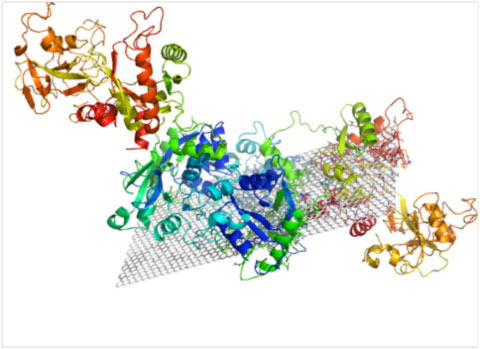| Posted: Jan 16, 2015 | |
Biodegradable graphene can radio-thermally ablate radiation and chemo resistant cancer cells |
|
| (Nanowerk Spotlight) Conventional cancer therapies such as chemo and radiation fail as cancer progresses with dynamic mutations at genomic and proteomic level. These cells are tough to destroy and patients are left with only palliative options at these advanced stages of the disease. Thus, managing resistant cancer cells is one of the major challenges faced by cancer researchers around the globe. | |
| One approach being researched is nanoparticle-mediated radio frequency ablation where heat energy is generated within the tumor by incident radio frequency (RF) waves resulting in coagulation necrosis of cells. The idea is that RF treatment of malignant tumors at any site in the body should be possible if it were possible to get agents that release heat under the influence of the RF field to the specific tumor site. | |
| Most RF ablation research so far has worked with gold nanoparticles – they are easily prepared and binding of cancer-targeting agents to the nanoparticles is easily achieved – though successful results have been demonstrated even with carbon nanotubes (read more: "Nanotechnology produces highly effective radio frequency absorbers for cancer therapy"). | |
| In new work, researchers from the Amrita Centre for Nanoscience and Molecular Medicine in India have developed a simple method to thermally ablate highly resistant cancer cells using targeted biodegradable graphene nanoparticles. | |
| Reporting their findings in the January 13, 2015 online edition of Advanced Healthcare Materials ("Radio frequency Ablation of Drug-Resistant Cancer Cells Using Molecularly Targeted Carboxyl-Functionalized Biodegradable Graphene"), the team found that graphene can convert non-ionizing radio waves – the same that are used in FM radios – into heat energy at microscopic levels. | |
| This heat is sufficient to completely destroy proteins and DNA inside individual cancer cells, irrespective of any kinds of resistant mechanisms that drives cancer cells at advanced stages. | |
 |
|
| Transferrin-conjugated graphene nanoparticles can thermally ablate drug or radiation-resistant cancer cells very effectively. (Image: Giridharan LM) | |
| "Our minimally invasive method makes use of very low-power radio waves, which can pass through any part of the body and generate heat energy only where biofunctionalized graphene nanoparticles are present," Dr. Abhilash Sasidharan, who is presently a Post-Doctoral Fellow at Kansas State University's Nanotechnology Innovation Center, and first author of the paper, tells Nanowerk. "Thus, once the graphene platelets are localized within the target tumor cells, the radio waves sent from outside the body can generate a sufficiently large amount of heat at highly localized, nanoscopic levels within the tumor and destroy all cellular proteins leading to cell death by a mechanism called coagulation necrosis." | |
| "Most importantly, since the heating process takes place only within cancer cells, damage to normal cells can be kept to a minimum," points out Amal J. Sivaram, who together with Sasidharan conducted the experiments. | |
| The researchers demonstrated this by targeting graphene nanoparticles to individual cancer cells using an iron-transport protein called transferrin, whose receptors over expressed in resistant cancer cells. After selective uptake of graphene nanoparticles by resistant cancer cells, a ultralow power (50 watts) radio frequency pulse was sent which ablated the cells very efficiently. | |
| "The preliminary in vitro results look promising, and we are proceeding to test these findings in animal models," says Prof. Shantikumar Nair, Director, Amrita Centre for Nanoscience and Molecular Medicine. Nevertheless, these results indicate an interesting new approach for destroying even the most resistant cancer cells non-invasively using bio-conjugated graphene nanoparticles and simple radio-waves that is otherwise used in our mobile phones." says Prof. Manzoor Koyakutty, who led the research. | |
 By
Michael
Berger
– Michael is author of three books by the Royal Society of Chemistry:
Nano-Society: Pushing the Boundaries of Technology,
Nanotechnology: The Future is Tiny, and
Nanoengineering: The Skills and Tools Making Technology Invisible
Copyright ©
Nanowerk LLC
By
Michael
Berger
– Michael is author of three books by the Royal Society of Chemistry:
Nano-Society: Pushing the Boundaries of Technology,
Nanotechnology: The Future is Tiny, and
Nanoengineering: The Skills and Tools Making Technology Invisible
Copyright ©
Nanowerk LLC
|
|
|
Become a Spotlight guest author! Join our large and growing group of guest contributors. Have you just published a scientific paper or have other exciting developments to share with the nanotechnology community? Here is how to publish on nanowerk.com. |
|
